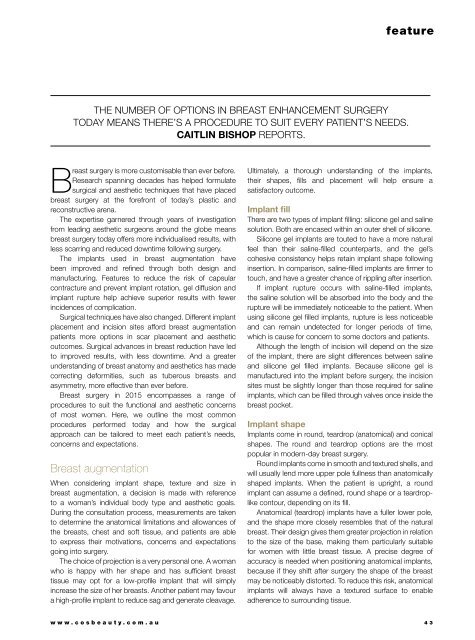Cosmetic Surgery and Beauty Magazine #68
You also want an ePaper? Increase the reach of your titles
YUMPU automatically turns print PDFs into web optimized ePapers that Google loves.
feature<br />
THE NUMBER OF OPTIONS IN BREAST ENHANCEMENT SURGERY<br />
TODAY MEANS THERE’S A PROCEDURE TO SUIT EVERY PATIENT’S NEEDS.<br />
CAITLIN BISHOP REPORTS.<br />
Breast surgery is more customisable than ever before.<br />
Research spanning decades has helped formulate<br />
surgical <strong>and</strong> aesthetic techniques that have placed<br />
breast surgery at the forefront of today’s plastic <strong>and</strong><br />
reconstructive arena.<br />
The expertise garnered through years of investigation<br />
from leading aesthetic surgeons around the globe means<br />
breast surgery today offers more individualised results, with<br />
less scarring <strong>and</strong> reduced downtime following surgery.<br />
The implants used in breast augmentation have<br />
been improved <strong>and</strong> refi ned through both design <strong>and</strong><br />
manufacturing. Features to reduce the risk of capsular<br />
contracture <strong>and</strong> prevent implant rotation, gel diffusion <strong>and</strong><br />
implant rupture help achieve superior results with fewer<br />
incidences of complication.<br />
Surgical techniques have also changed. Different implant<br />
placement <strong>and</strong> incision sites afford breast augmentation<br />
patients more options in scar placement <strong>and</strong> aesthetic<br />
outcomes. Surgical advances in breast reduction have led<br />
to improved results, with less downtime. And a greater<br />
underst<strong>and</strong>ing of breast anatomy <strong>and</strong> aesthetics has made<br />
correcting deformities, such as tuberous breasts <strong>and</strong><br />
asymmetry, more effective than ever before.<br />
Breast surgery in 2015 encompasses a range of<br />
procedures to suit the functional <strong>and</strong> aesthetic concerns<br />
of most women. Here, we outline the most common<br />
procedures performed today <strong>and</strong> how the surgical<br />
approach can be tailored to meet each patient’s needs,<br />
concerns <strong>and</strong> expectations.<br />
Breast augmentation<br />
When considering implant shape, texture <strong>and</strong> size in<br />
breast augmentation, a decision is made with reference<br />
to a woman’s individual body type <strong>and</strong> aesthetic goals.<br />
During the consultation process, measurements are taken<br />
to determine the anatomical limitations <strong>and</strong> allowances of<br />
the breasts, chest <strong>and</strong> soft tissue, <strong>and</strong> patients are able<br />
to express their motivations, concerns <strong>and</strong> expectations<br />
going into surgery.<br />
The choice of projection is a very personal one. A woman<br />
who is happy with her shape <strong>and</strong> has suffi cient breast<br />
tissue may opt for a low-profi le implant that will simply<br />
increase the size of her breasts. Another patient may favour<br />
a high-profi le implant to reduce sag <strong>and</strong> generate cleavage.<br />
Ultimately, a thorough underst<strong>and</strong>ing of the implants,<br />
their shapes, fi lls <strong>and</strong> placement will help ensure a<br />
satisfactory outcome.<br />
Implant fill<br />
There are two types of implant fi lling: silicone gel <strong>and</strong> saline<br />
solution. Both are encased within an outer shell of silicone.<br />
Silicone gel implants are touted to have a more natural<br />
feel than their saline-fi lled counterparts, <strong>and</strong> the gel’s<br />
cohesive consistency helps retain implant shape following<br />
insertion. In comparison, saline-fi lled implants are fi rmer to<br />
touch, <strong>and</strong> have a greater chance of rippling after insertion.<br />
If implant rupture occurs with saline-fi lled implants,<br />
the saline solution will be absorbed into the body <strong>and</strong> the<br />
rupture will be immediately noticeable to the patient. When<br />
using silicone gel fi lled implants, rupture is less noticeable<br />
<strong>and</strong> can remain undetected for longer periods of time,<br />
which is cause for concern to some doctors <strong>and</strong> patients.<br />
Although the length of incision will depend on the size<br />
of the implant, there are slight differences between saline<br />
<strong>and</strong> silicone gel fi lled implants. Because silicone gel is<br />
manufactured into the implant before surgery, the incision<br />
sites must be slightly longer than those required for saline<br />
implants, which can be fi lled through valves once inside the<br />
breast pocket.<br />
Implant shape<br />
Implants come in round, teardrop (anatomical) <strong>and</strong> conical<br />
shapes. The round <strong>and</strong> teardrop options are the most<br />
popular in modern-day breast surgery.<br />
Round implants come in smooth <strong>and</strong> textured shells, <strong>and</strong><br />
will usually lend more upper pole fullness than anatomically<br />
shaped implants. When the patient is upright, a round<br />
implant can assume a defi ned, round shape or a teardroplike<br />
contour, depending on its fi ll.<br />
Anatomical (teardrop) implants have a fuller lower pole,<br />
<strong>and</strong> the shape more closely resembles that of the natural<br />
breast. Their design gives them greater projection in relation<br />
to the size of the base, making them particularly suitable<br />
for women with little breast tissue. A precise degree of<br />
accuracy is needed when positioning anatomical implants,<br />
because if they shift after surgery the shape of the breast<br />
may be noticeably distorted. To reduce this risk, anatomical<br />
implants will always have a textured surface to enable<br />
adherence to surrounding tissue.<br />
www.cosbeauty.com.au 43


















